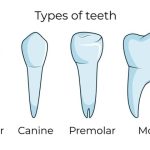How To Fix Macrodontia?
What Is Macrodontia?
Macrodontia teeth refers to a dental condition characterized by abnormally large teeth. It can affect both the primary (baby) teeth and/or the permanent teeth. Individuals with macrodontia may have teeth that are significantly larger in size compared to the average tooth dimensions. This condition can occur in one or more teeth, affecting the overall appearance and function of the smile.
According to Proffit et al. (2019), macrodontia is a rare dental condition characterized by teeth that are larger than normal. It can result from genetic factors or developmental abnormalities during tooth formation. Macrodontia can occur in both primary and permanent teeth, and it may affect a single tooth or multiple teeth. The size discrepancy of macrodontic teeth can vary, with some teeth being slightly larger than average and others exhibiting a significant size difference.
Macrodontia can have various effects on the affected individuals. The enlarged size of the teeth can lead to aesthetic concerns, as the appearance of the smile may be noticeably different. Additionally, macrodontic teeth may cause functional issues such as occlusal or bite discrepancies and difficulties in maintaining proper oral hygiene. In severe cases, they can also contribute to malocclusions and bite problems.
Orthodontic treatment plays a crucial role in addressing macrodontia and correcting the associated dental concerns. According to a case report by Kim et al. (2016), orthodontic intervention can help manage macrodontic teeth and improve the overall aesthetics and functionality of the patient’s smile. Treatment options may include the use of orthodontic appliances like braces, clear aligners, palatal expanders, or a combination of these, depending on the specific needs of the patient.
Alignment and positioning of teeth is a primary goal of orthodontic treatment. Braces, which consist of brackets and wires, exert controlled forces to gradually move the teeth into their proper alignment. Clear aligners, such as Invisalign, provide a more discreet option for addressing conditions like macrodontia. They are removable and transparent trays that apply gentle forces to guide the teeth into their desired positions.
In some cases, palatal expanders may be utilized to create additional space for the proper alignment of macrodontic teeth. These appliances help widen the upper jaw, allowing the teeth to be positioned more harmoniously within the dental arch. Orthodontic treatment may also involve bite correction, as misaligned macrodontic teeth can affect the overall occlusion. By correcting the bite relationship, orthodontic interventions help improve chewing efficiency and prevent further dental complications.
It is important to note that orthodontic treatment for macrodontia should be carried out under the guidance of qualified dental professionals. Orthodontists or dentists with experience in treating macrodontia can properly assess the condition, develop an individualized treatment plan, and monitor the progress to achieve optimal outcomes.
How Orthodontic Treatment Can Correct Big Teeth?
Orthodontic treatment plays a crucial role in correcting big teeth associated with macrodontia. By utilizing various orthodontic appliances and techniques, orthodontists can address the following aspects:
Alignment and Positioning: Orthodontic treatment helps align and position the big teeth properly within the dental arch, ensuring a more harmonious and functional bite.
Space Management: In cases where macrodontia leads to crowding or spacing issues, orthodontic treatment helps create sufficient space or close gaps between the teeth for an aesthetically pleasing and properly aligned smile.
Bite Correction: Misaligned big teeth can also affect the bite relationship between the upper and lower jaw. Orthodontic interventions, such as braces or aligners, can correct the bite to improve chewing efficiency and overall oral health.
Aesthetic Enhancement: Orthodontic treatment not only addresses functional concerns but also improves the aesthetics of the smile by creating a balanced and proportionate tooth appearance.
Teeth shaving: Teeth shaving, also known as enameloplasty or enamel reduction, is a dental procedure that involves removing a small amount of tooth enamel to reshape or resize the teeth. It is typically performed to address minor irregularities, such as slight overlaps or points of contact between teeth. While teeth shaving can provide immediate cosmetic improvements, it is essential for individuals to seek orthodontic help before considering this procedure.
Orthodontists are specialists trained in evaluating the overall alignment and bite of the teeth, and they can determine if teeth shaving is necessary or if alternative orthodontic treatments would be more appropriate. Seeking orthodontic help ensures that the underlying causes of the dental irregularities are properly addressed, preventing potential complications and ensuring long-term dental health and stability.
Comprehensive Treatment Approach: Orthodontists develop individualized treatment plans based on the severity and specific needs of each patient. This comprehensive approach ensures that all aspects of macrodontia and associated dental concerns are properly addressed.
The opposite dental problem, microdontia teeth, is when the teeth are too small. This should also be assessed by your orthodontist and addressed with gum laser treatments or other treatments.
Which Orthodontic Appliances Are Commonly Used to Fix Big Teeth and Achieve Proper Alignment?
Orthodontic appliances play a vital role in addressing big teeth and achieving proper alignment. There are several commonly used appliances that orthodontists may employ in the treatment process:
Braces: Traditional braces consist of metal brackets and wires that are affixed to the teeth. These braces apply controlled forces to gradually move the teeth into their desired positions. By adjusting the tension of the wires, orthodontists can effectively correct the alignment of big teeth and improve overall dental occlusion.
Clear Aligners: Clear aligners, such as Invisalign, are transparent removable trays that fit snugly over the teeth. They offer a discreet alternative to traditional braces and are particularly popular among individuals who desire a more aesthetic treatment option. Clear aligners apply gentle forces to the teeth, gradually shifting them into their proper alignment.
Palatal Expanders: Palatal expanders are orthodontic appliances used to widen the upper jaw. They are commonly employed when there is insufficient space in the dental arch for the proper alignment of big teeth. By gradually expanding the palatal space, these appliances create additional room, allowing the teeth to be positioned more harmoniously.
Orthodontic Headgear: Orthodontic headgear may be recommended in cases where bite discrepancies and jaw alignment issues are present. Headgear exerts external forces on small teeth, big teeth, long teeth, and jaws, helping to correct these irregularities. It is typically worn for a specified period of time as directed by the orthodontist.
Retainers: Retainers are an essential part of orthodontic treatment, used after active treatment with braces or aligners. They help maintain the achieved results and prevent regression of tooth movement. Retainers are custom-made appliances that are typically worn for an extended period, especially during the initial phase when the teeth are most susceptible to shifting.
It is important to note that the selection of orthodontic appliances depends on various factors, including the specific needs of the individual and the severity of the dental condition. Orthodontists carefully assess each case to determine the most suitable treatment approach and appliance type so that you can get that small teeth smile.
In conclusion, orthodontic appliances are instrumental in correcting big teeth and achieving proper alignment. Braces, clear aligners, palatal expanders, orthodontic headgear, and retainers are commonly used to address these dental concerns. By applying targeted forces and creating space, these appliances help orthodontists achieve optimal dental alignment and improve the overall dental aesthetics and function of individuals with a big teeth smile.
If you don’t yet have an orthodontist, give us a call today at 786-540-1919 or book an appointment using the link here.



